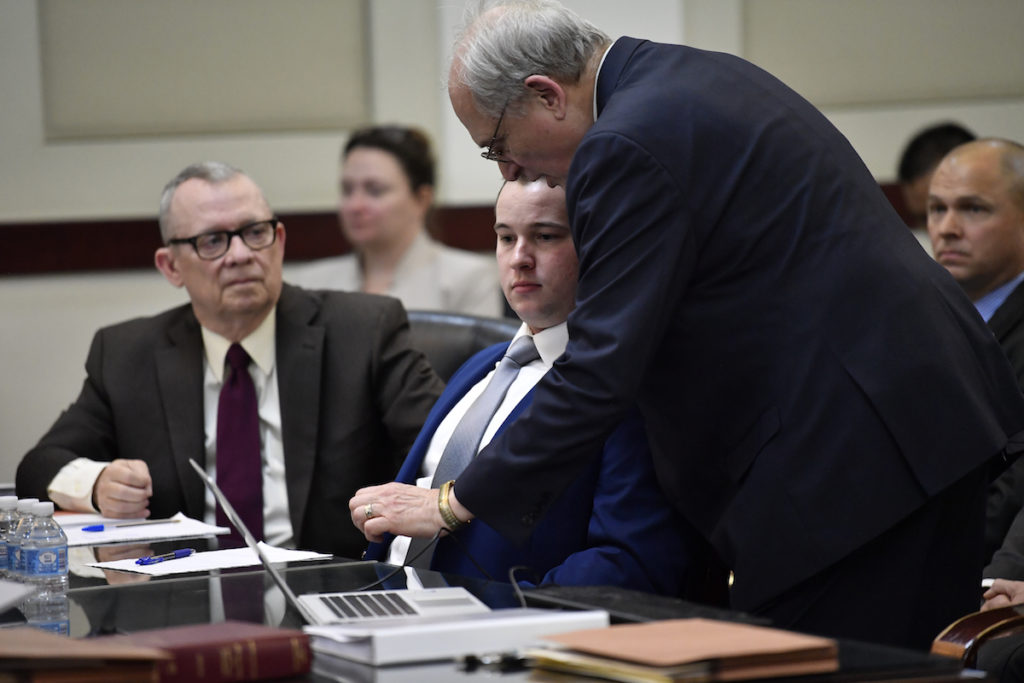
Battle lines were drawn Saturday by competing legal teams as they concluded the preliminary hearing for the homicide case against Nashville Officer Andrew Delke.
On one side, prosecutors repeatedly emphasized that the officer chose to shoot Daniel Hambrick in the back as the 25-year-old was “running full steam away from him,” as one prosecutor said.
On the other, defense attorneys argue Delke closely followed his police training, reacted appropriately to Hambrick’s possession of a gun, and that he followed the law governing use of force by police.
During about 50 minutes of closing arguments, the two sides tried to pick apart the details presented during more than six hours of testimony. But they also tried to distill the case to its core elements — ultimately arriving at starkly different narratives.
For the prosecution, which is trying to convince the judge to advance the case to the grand jury, the case boils down to the officer’s decision-making.
“[The officer] makes the decision he’s chased him as far as he’s going to chase him — he makes the decision to shoot and to shoot to kill,” said Assistant District Attorney Roger Moore. “He fired, shot and killed Daniel Hambrick, not because he had to, but because he chose to.”
District Attorney Glenn Funk contrasted the actions of Hambrick and the officer. He said Hambrick was “doing everything he could to avoid a confrontation.” Delke, though, acted with intention to kill him, he said.
“He stands tall. He takes his time. He makes sure these [shots] are going to kill Daniel Hambrick. That’s not somebody who’s afraid of an imminent threat,” Funk told the court. “Any person in Davidson County who shoots someone who is running away from them, shoots them in the back and kills them, needs to be held accountable.”
The defense, however, argued that Delke’s actions were reasonable given the situation.
“If a killing is done … pursuant to the police statute, it’s not unlawful,” said defense attorney David Raybin.
The defense said the officer had “abundant cause” to pursue Hambrick that day. As Hambrick fled and revealed that he had a gun, the officer was within the law to open fire.
“A police officer has privileges that we as normal citizens don’t enjoy,” Raybin said. “He’s not some rogue cop running amok on the streets. He’s a professional.”
Raybin went further, directing blame to the men who were riding in the car with Hambrick on the day of the shooting. As video shows, the men quickly exited their vehicle shortly before the officer arrived and split off in different directions, ultimately concealing items at nearby residences.
Hambrick alone took off in a sprint. Raybin contends Hambrick was acting as an intentional “decoy” that day who baited the officer into a chase and then became an “imminent threat.”
“He was not only a decoy, but judge, he was a sacrifice,” Raybin said. “It was like he had a big sign over his head: ‘Chase me, follow me.’ “
Raybin concluded by saying that the officer doesn’t really need defending. “He followed his training. He followed the law. And he is not guilty of any crime.”
It will be up to Judge Melissa Blackburn to determine whether the case advances to the Davidson County Grand Jury, which would review the facts and determine whether a criminal indictment was warranted.
Blackburn said she would rule in writing today.
Police Training Examined
Earlier in the day, the final witness of the preliminary hearing testified about how police officers train to use deadly force.
Former Metro Sgt. Bob Allen concluded Delke “did exactly what he was trained to do” and could not have used other means to stop Hambrick, such as a Taser. And in his viewing of video of the incident, Allen said Hambrick showed threatening signs, such as taking “targeting glances” at the officer while running — a point contested by prosecutors throughout the hearing.
Allen also detailed the gun that Hambrick was carrying and emphasized the speed at which he could have fired a shot at the officer. He said officers are trained that “action beats reaction” — meaning that even when an officer has a gun drawn and aimed at a suspect, they risk being shot if the suspect is the first to decide to shoot.
Judge Reverse Calls
During the hearing Saturday, legal teams also clashed about photographs of Hambrick. After initially allowing certain images as evidence, Judge Blackburn ultimately decided against them.
At issue was a defense attempt to show that Hambrick was left-handed. But prosecutors argued the images were mostly an attempt to “slur” and “humiliate the victim,” because of what they showed.
The judge also reversed course on one other matter Saturday: She allowed local news station WKRN to continue recording the proceedings. The night before, as testimony concluded, Blackburn lashed out at a reporter about a potential violation of the judge’s ban on live-streaming of the hearing. By Saturday, the station had explained that streaming had not occurred, and their coverage continued.
The judge barred journalists from live-streaming or “social media coverage,” and barred the use of cellphones within the courtroom.
Hearing Recounts July Shooting In Detail
Delke, 25, is charged in the July 26, 2018, fatal shooting of Hambrick, who was running away from the officer with a gun when the he was shot three times.
More:
Police Officer Charged With Homicide For On-Duty Shooting
The preliminary hearing for Officer Andrew Delke began Friday afternoon in front of a packed Nashville courtroom, including dozens of Nashville police officers and friends and family of shooting victim Daniel Hambrick.
The hearing was abnormally detailed, lasting more than five hours on Friday and including a total of six witnesses: a pair of Nashville police officers, an agent with the Tennessee Bureau of Investigation, a medical examiner, a video expert, and a police training expert.
The state investigator described discrepancies between Delke’s account and video evidence, and a medical examiner detailed the three gunshots that struck and killed Daniel Hambrick on July 26, 2018.
The examiner, Miguel Laboy, ruled Hambrick’s death a homicide from multiple gunshots, and identified one shot to Hambrick’s head and one to his back, which entered his lung, as lethal. A third shot to Hambrick’s back entered his spine.
Later in the afternoon, defense attorneys called two Metro officers and a video forensics expert. Their testimony explained how additional backup officers arrived after Delke shot Hambrick. Officer Trevin Tolbert explained that officers followed department protocol when handcuffing Hambrick after he’d been shot.
Lt. Blaine Whited, who supervised Delke, testified that the officer was “alert and aware” while chasing and shooting Hambrick. He called attention to the clarity of Delke’s messages sent over his police radio during the chase, including Delke’s call of “54,” which police use to identify guns.
The defense’s video expert presented annotated surveillance footage, which occupies a central place in the trial.
Of note, the expert estimated that Hambrick and Delke may have spent 3 seconds out of camera view. That time was referenced repeatedly as a moment when Hambrick may have pointed his gun at Delke, although prosecutors disputed the feasibility of that maneuver.
Discrepancies At The Fore
Officer Andrew Delke, the Metro officer charged with homicide, did not testify, but a video was played in court of his interview by TBI Special Agent Steven Kennard.
undefinedIn the video, Delke recounts his chase and fatal shooting of Hambrick, and characterizes his decision to shoot as a response to what he perceived as an “imminent threat” from Hambrick, who was running with a gun.
undefinedundefinedDelke told investigators that the confrontation in a parking lot included Hambrick refusing multiple commands to stop running, and that Hambrick had drawn a gun from his waistband and pointed it toward the officer.undefined
undefined
undefinedundefinedDelke said he repeatedly yelled for Hambrick to drop the gun, quickly deciding that he might be in danger.undefinedundefined
undefined
undefined
undefinedundefined“I yell one more time, ‘Drop the gun or I’m going to shoot you,’ ” the officer told investigators. “I knew 100 percent his intent was to use that gun against me … so I decide to take action to beat his action and fired the shots to neutralize what I perceived as an imminent threat.”undefinedundefined
undefined
undefined
undefinedundefinedBut Kennard, the TBI agent, could not find any video evidence of Hambrick turning toward Delke or pointing a gun at him. The agent noted that there was a 36-foot space that Delke chased Hambrick through that was not recorded — but Hambrick’s sprint through that space lasted about 2 seconds, and the agent said it would have been “very difficult” for Hambrick to have pointed a gun at the officer in that space.undefinedundefined
undefined
undefinedIn the interview, Delke also described a low-speed car chase that preceded the foot chase and shooting. Delke said he briefly pursued a car in North Nashville that night, lost track of it, and spotted it again entering a parking lot of the J. Henry Hale housing complex, where the foot chase and shooting occurred.undefined
undefined
undefined
undefinedundefinedHowever, Kennard, testified that Delke’s statements revealed he misidentified the white car that Hambrick had been in.undefinedundefined
undefined
undefined
undefinedundefinedJust before the foot chase, there were three similar white cars in the parking lot. Delke said he parked near the white car he had been pursuing, but video shows Hambrick’s car was actually more than 100 feet away.undefinedundefined
undefined
undefined
undefinedundefinedAs part of his interview with investigators, Delke also described his two years with Metro Police. The shooting occurred while Delke was working for the agency’s Juvenile Crime Task Force. He’d been assigned to that role about two weeks before the shooting.undefinedundefined
undefined
undefined
undefinedundefined“The main thing we’re looking for is stolen cars, violent criminals,” Delke told investigators.undefinedundefined
undefined
undefined
undefinedundefinedThe officer said he had only experienced one prior use-of-force incident, about a month before the shooting, in which he fought with an aggressive drunk man during an arrest. Delke said he hadn’t previously fired his gun, deployed a Taser or sprayed pepper spray.undefinedundefined
undefined
undefined
undefinedundefinedAbout 50 minutes of Delke’s interview was played in court before the judge interjected, asking the prosecution not to waste anyone’s time by playing irrelevant portions.undefinedundefined
undefined
undefined
undefinedundefined“This is not the trial. This is probable cause,” she told the prosecutors.undefinedundefined
undefined
undefined
undefinedundefinedThe hearing was seen as a key test of the prosecution’s evidence, with the officer’s attorney, Raybin, probing how prosecutors handled the case. undefinedundefined
undefined
undefined
undefinedundefinedIn a prior hearing, he pointed out that a TBI agent wasn’t comfortable presenting the facts in court, and that the initial magistrate involved with the case didn’t find probable cause to sign a charging warrant. But District Attorney Glenn Funk has tried to brush off the critique as procedural nitpicking. undefinedundefined
undefined
undefined
undefinedThis story was last updated on Jan. 7 at 6:39 a.m.undefined
 undefined
undefinedundefined


